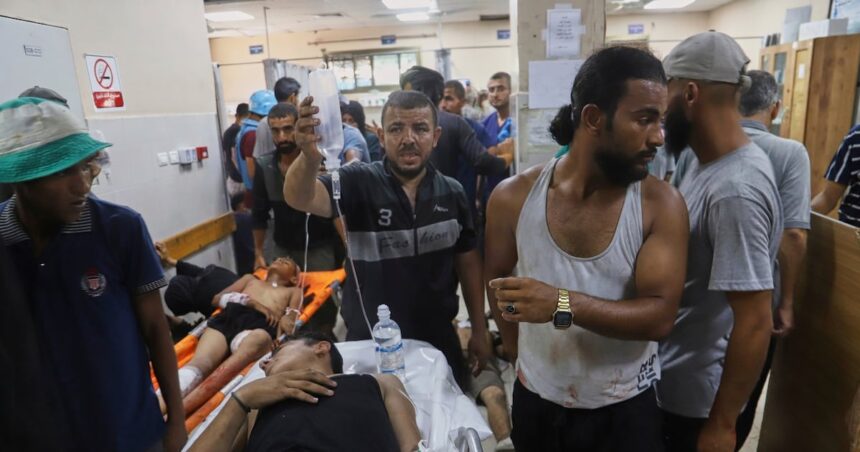The darkness had barely lifted over northern Gaza when thousands gathered near Kuwait Square. Their mission—simple survival. Their hope—sacks of flour from an incoming aid convoy. What happened next continues to reverberate across diplomatic channels and humanitarian offices worldwide.
“The bullets came from everywhere,” recounted Mahmoud al-Najjar, a 43-year-old father of six who escaped with minor injuries. “People were just trying to get food for their children. There was no warning.”
At least 22 Palestinians were killed Thursday when Israeli forces opened fire on crowds waiting for humanitarian aid, according to Gaza health officials and multiple eyewitness accounts. Over 150 others were wounded in what represents one of the deadliest incidents involving civilians seeking humanitarian assistance since the war began.
The Israeli military offers a different narrative. Officials claim armed militants had approached their forces amid the crowd, prompting defensive fire. “We identified several armed individuals moving suspiciously toward our position,” an IDF spokesperson stated. “Our forces responded according to threat assessment protocols.”
Yet reports from the ground paint a more complicated picture. Aid workers present described a desperate scene where thousands had gathered after hearing rumors of flour distribution. The World Food Programme had warned last week that Gaza stands “at the precipice of famine,” with nearly 80% of the northern population facing catastrophic food insecurity.
Philippe Lazzarini, Commissioner-General of UNRWA, called the incident “unconscionable” in a statement released hours after the shooting. “Humanitarian aid cannot be delivered at gunpoint,” he said. “Each convoy requires coordination, protection, and guaranteed safe passage.”
The shooting underscores the increasingly dangerous conditions facing both civilians and aid workers in Gaza. Since October, at least 27 UN personnel have been killed, making this the deadliest conflict for humanitarian workers in the organization’s history.
“What we’re witnessing is the collapse of humanitarian principles in real-time,” explained Dr. Maha Nassar, a Middle East analyst who recently returned from assessing conditions at border crossings. “When people fear being shot while seeking flour, we’ve crossed a threshold that should alarm everyone concerned with international humanitarian law.”
The timing proves particularly troubling as cease-fire negotiations in Qatar appeared to be making incremental progress. Egyptian officials involved in the talks indicated the incident may complicate efforts to reach even a temporary humanitarian pause.
For residents of northern Gaza, Thursday’s violence represents just another day in an increasingly impossible situation. Local health authorities report that nearly one-third of children under five now suffer from acute malnutrition. The UN estimates daily caloric intake has fallen below 500 calories per person in some areas—less than a quarter of recommended minimums.
“We’ve been eating grass and animal feed,” said Amal Riyad, a mother of four who witnessed the shooting from a nearby building. “My children cry from hunger every night. What choice do we have but to risk everything for a bag of flour?”
The incident highlights systemic failures in aid delivery despite multiple UN Security Council resolutions calling for unimpeded humanitarian access. According to OCHA data, less than 20% of required aid has entered Gaza over the past month, with northern areas receiving the smallest proportion.
International reaction has been swift and divided. The United States expressed “serious concern” and called for a thorough investigation, while Jordan’s Foreign Ministry described it as a “war crime requiring immediate accountability.”
Dr. Rabab al-Sadi, a physician at Al-Awda Hospital who treated victims, described injuries consistent with high-velocity ammunition. “These were not warning shots,” she insisted. “Many had wounds to the upper body and head. Some victims were women and teenagers who posed no conceivable threat.”
The Israeli military announced it would review the incident through its operational investigation mechanism, though previous investigations have rarely resulted in disciplinary action against military personnel.
For those in northern Gaza, investigations offer little comfort as they continue the daily struggle to find food, water, and medicine. Aid agencies warn that without significant changes to humanitarian access protocols, similar incidents remain inevitable as desperation grows.
“People don’t gather under gunfire for flour unless they have absolutely nothing left,” observed Mohammed Abu Selmiya, director of Al-Shifa Hospital. “This is the reality of Gaza today: death by bombardment, death by starvation, or death while seeking aid.”
As night fell over Kuwait Square, families mourned their dead while others returned home empty-handed, facing another day of hunger in a war that continues to extract its heaviest toll on civilians caught between military operations and humanitarian collapse.






